The Conference Venue Évian-les-Bains
Switzerland declines to open the conference in Geneva, the headquarters of the League of Nations. The French government offers Évian-les-Bains in the Haute-Savoie department as an alternative venue. Located on the French shore of Lake Geneva, it has a railway connection via Lyon to Paris, making it easy for conference participants to reach the French capital in time for the visit of the British royal couple, scheduled for July 19, 1938.
In 1793, a nobleman who had fled the French Revolution to Évian, then still a part of the Savoy, had discovered the healing powers of the local waters. By the last third of the 19th century, Évian becomes a chic lakeside resort and a meeting place for international high society. Its spacious and luxurious hotels offer a conference room as well as comfortable accommodations. Guests an enjoy swimming pools, refreshments, golf courses, tennis courts, horse races, the casino and the beach in their spare time.
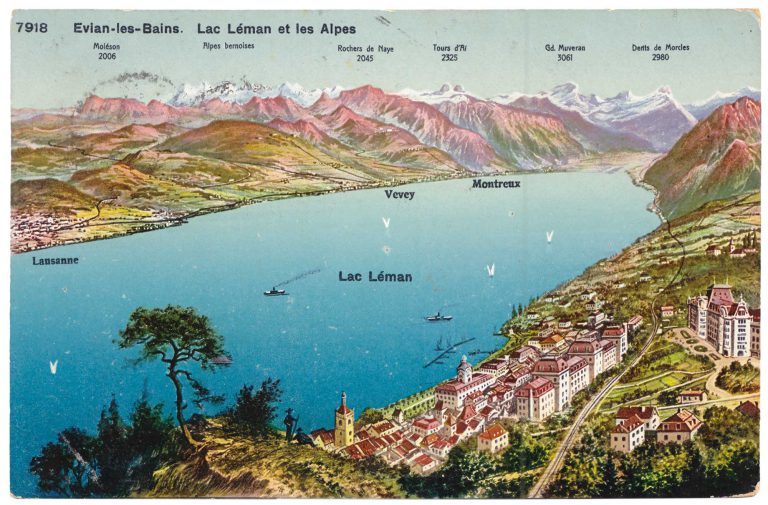
Picture postcard of Évian and Lake Geneva, around 1900
The card depicts a view from the Dent d’Oche, Évian’s mountain, over the city and Lake Geneva (French: Lac Léman) to the northernmost region of the French Alps. To the far right is the Hotel Royal, the conference venue and accommodation for numerous delegates; to the left is the Hotel Splendide, which houses other delegates, representatives of non-governmental organizations and media representatives.
Phototypie Co., Neuchatel
Picture postcard of Évian and Lake Geneva, around 1900
The card depicts a view from the Dent d’Oche, Évian’s mountain, over the city and Lake Geneva (French: Lac Léman) to the northernmost region of the French Alps. To the far right is the Hotel Royal, the conference venue and accommodation for numerous delegates; to the left is the Hotel Splendide, which houses other delegates, representatives of non-governmental organizations and media representatives.
Phototypie Co., Neuchatel
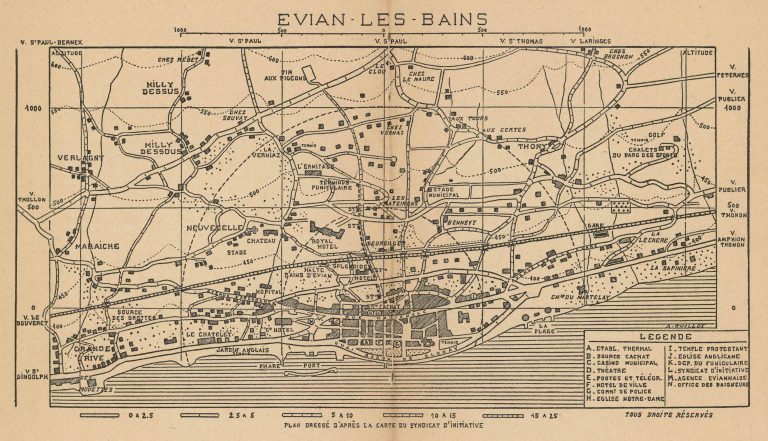
City map of Évian-les-Bains, 1930
Adolphe Guilllot / Universitätsbibliothek Basel
City map of Évian-les-Bains, 1930
Adolphe Guilllot / Universitätsbibliothek Basel
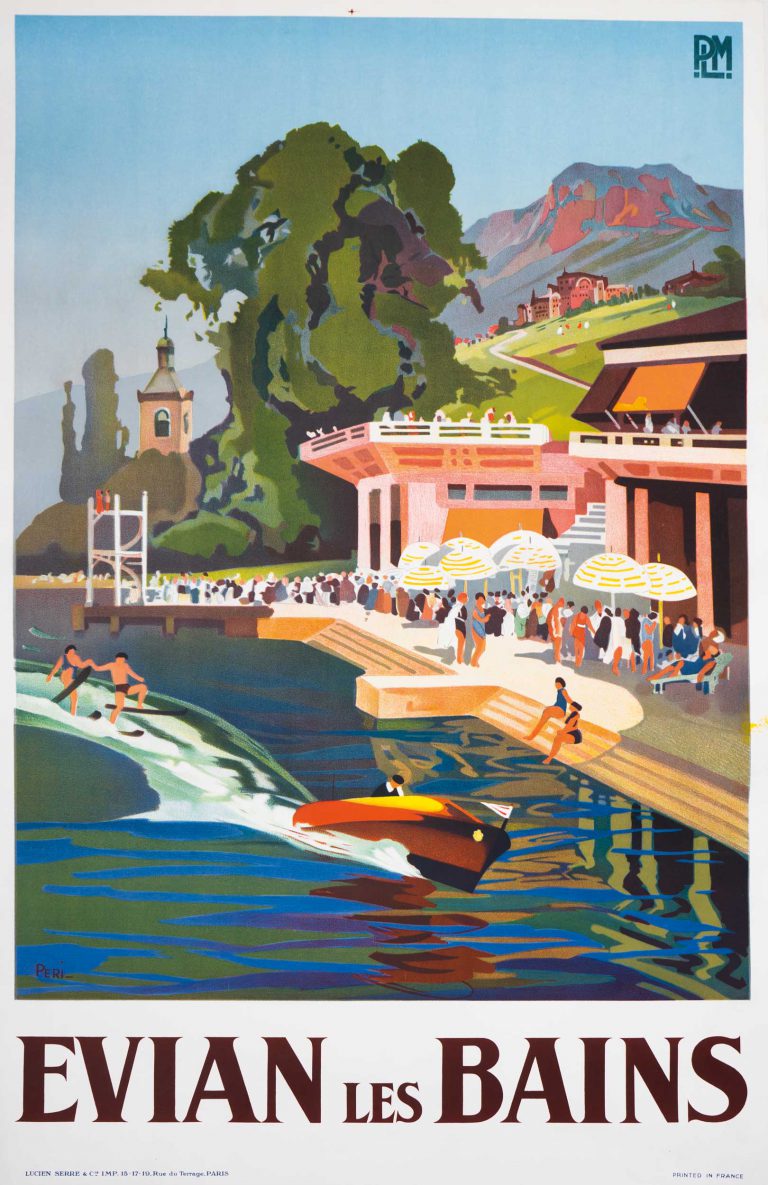
Évian-les-Bains advertising poster, based on a design by the Corsican landscape and graphic artist Lucien Peri (1880–1948), ca. 1930
With the democratization of many societies after World War I, Évian’s five luxury hotels lose much of their noble clientele. For economic reasons, the city must now pitch itself as a recreational and leisure paradise for the wealthy French bourgeoisie. The number of guests increases from 13,000 in the pre-war period to 18,000 in 1929; of these, 8,500 come from abroad.
Zentrum für Antisemitismusforschung / Technische Universität Berlin – Repro: Jean-Charles Giroud
Évian-les-Bains advertising poster, based on a design by the Corsican landscape and graphic artist Lucien Peri (1880–1948), ca. 1930
With the democratization of many societies after World War I, Évian’s five luxury hotels lose much of their noble clientele. For economic reasons, the city must now pitch itself as a recreational and leisure paradise for the wealthy French bourgeoisie. The number of guests increases from 13,000 in the pre-war period to 18,000 in 1929; of these, 8,500 come from abroad.
Zentrum für Antisemitismusforschung / Technische Universität Berlin – Repro: Jean-Charles Giroud
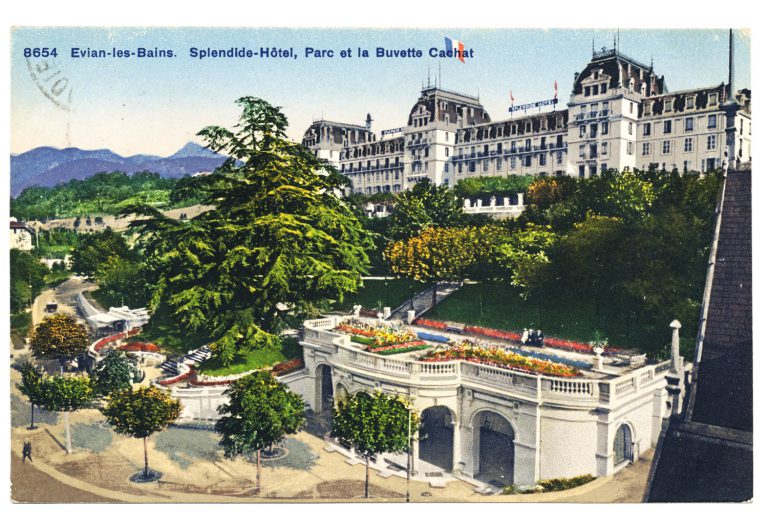
Hotel Splendide and Cachat Refreshment Hall, around 1919
The Hotel Splendide is built in 1839 as L’Hôtel des Bains, above the famed spring of the Cachat family. It is expanded several times. In 1898, following the last expansion, the majestic building is renamed Hotel Splendide. A park connects the hotel with the Refreshment Hall, built in 1900 above the Cachat spring. Supposedly to protect the spring, but probably more for economic reasons, the Hotel Splendide is demolished in 1983.
Phototypie Co., Neuchatel
Hotel Splendide and Cachat Refreshment Hall, around 1919
The Hotel Splendide is built in 1839 as L’Hôtel des Bains, above the famed spring of the Cachat family. It is expanded several times. In 1898, following the last expansion, the majestic building is renamed Hotel Splendide. A park connects the hotel with the Refreshment Hall, built in 1900 above the Cachat spring. Supposedly to protect the spring, but probably more for economic reasons, the Hotel Splendide is demolished in 1983.
Phototypie Co., Neuchatel
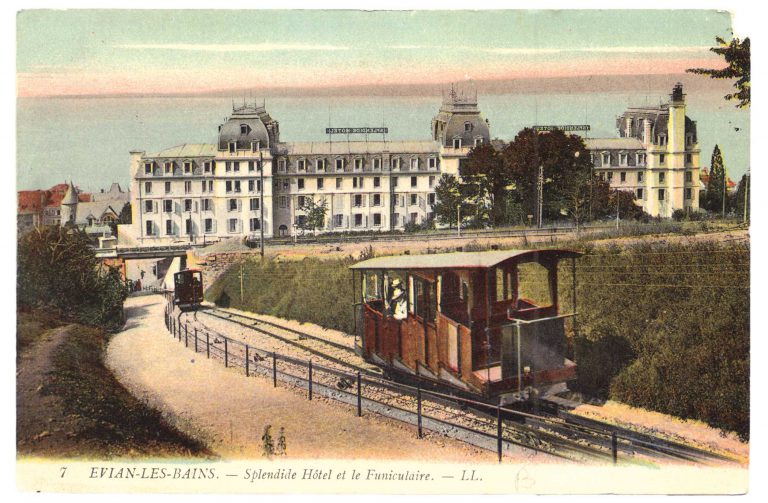
Picture postcard of the Hotel Splendide with cable car, around 1907
By 1907, a cable car is operating on a 357-meter-long track, which leads from the Cachat spring’s Refreshment Hall, i.e. the Hotel Splendide, to the Hotel Royal at a higher elevation, with only one station stop between them. In 1913 the rail line is extended in both directions and now stops at a total of six stations. This allows conference participants to travel easily back and for th between conference room, accommodations and entertainment venues in the city center.
Léon & Lévy, LL7
Picture postcard of the Hotel Splendide with cable car, around 1907
By 1907, a cable car is operating on a 357-meter-long track, which leads from the Cachat spring’s Refreshment Hall, i.e. the Hotel Splendide, to the Hotel Royal at a higher elevation, with only one station stop between them. In 1913 the rail line is extended in both directions and now stops at a total of six stations. This allows conference participants to travel easily back and for th between conference room, accommodations and entertainment venues in the city center.
Léon & Lévy, LL7
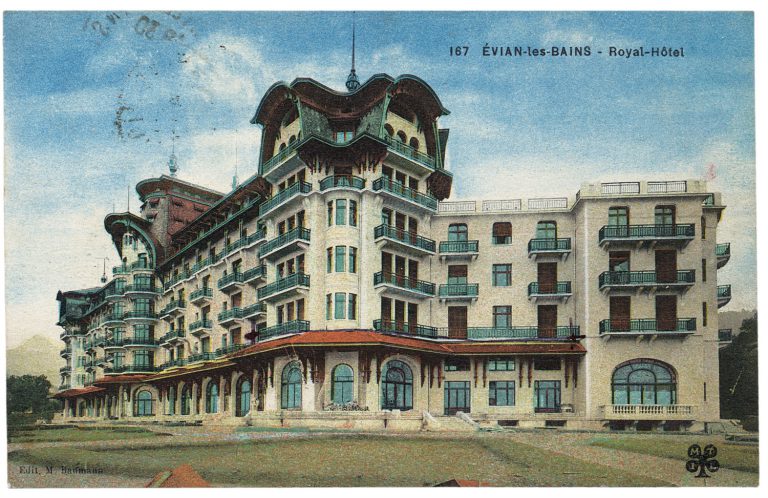
Picture postcard of the Hotel Royal in Évian-les-Bains, around 1927
The Hotel Royal, which opens in 1909, is planned by the Société des Eaux Minérales d’Évian as “Europe’s most beautiful hotel.” Built in the British-Norman style, it is named for the British king Edward VII. A suite is always reserved for him there, but he dies in 1910 without ever setting foot in it. Still, the Hotel Royal soon becomes the preferred residence for members of the European aristocracy, Middle Eastern potentates and writers like Marcel Proust, who is said to have written par ts of “Remembrance of Things Past” there.
Edit. M. Hoffmann / Maurice Tesson Imprimeur Limoges
Picture postcard of the Hotel Royal in Évian-les-Bains, around 1927
The Hotel Royal, which opens in 1909, is planned by the Société des Eaux Minérales d’Évian as “Europe’s most beautiful hotel.” Built in the British-Norman style, it is named for the British king Edward VII. A suite is always reserved for him there, but he dies in 1910 without ever setting foot in it. Still, the Hotel Royal soon becomes the preferred residence for members of the European aristocracy, Middle Eastern potentates and writers like Marcel Proust, who is said to have written par ts of “Remembrance of Things Past” there.
Edit. M. Hoffmann / Maurice Tesson Imprimeur Limoges
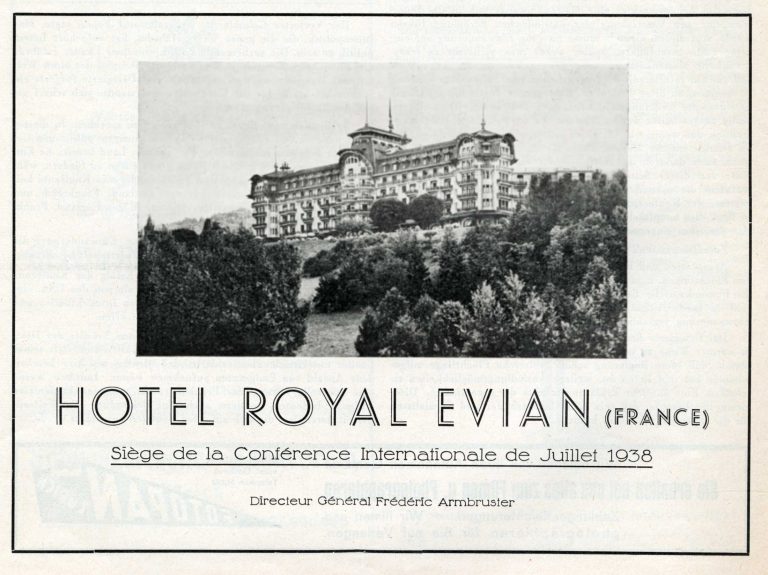
Advertisement promoting the Hotel Royal as the “venue for the international conference of July 1938”
The 1938 Refugee Conference establishes Évian as a site for high-level international meetings. At later conferences in Évian – in May 1961 and March 1962 – France and the Algerian National Liberation Front agree on a ceasefire and on Algeria’s independence. In early June 2003, the Évian Summit of the eight most important industrial nations takes place.
Jüdische Presszentrale Zürich, No. 999/1000 / Archiv für Zeitgeschichte / ETH Zürich
Advertisement promoting the Hotel Royal as the “venue for the international conference of July 1938”
The 1938 Refugee Conference establishes Évian as a site for high-level international meetings. At later conferences in Évian – in May 1961 and March 1962 – France and the Algerian National Liberation Front agree on a ceasefire and on Algeria’s independence. In early June 2003, the Évian Summit of the eight most important industrial nations takes place.
Jüdische Presszentrale Zürich, No. 999/1000 / Archiv für Zeitgeschichte / ETH Zürich
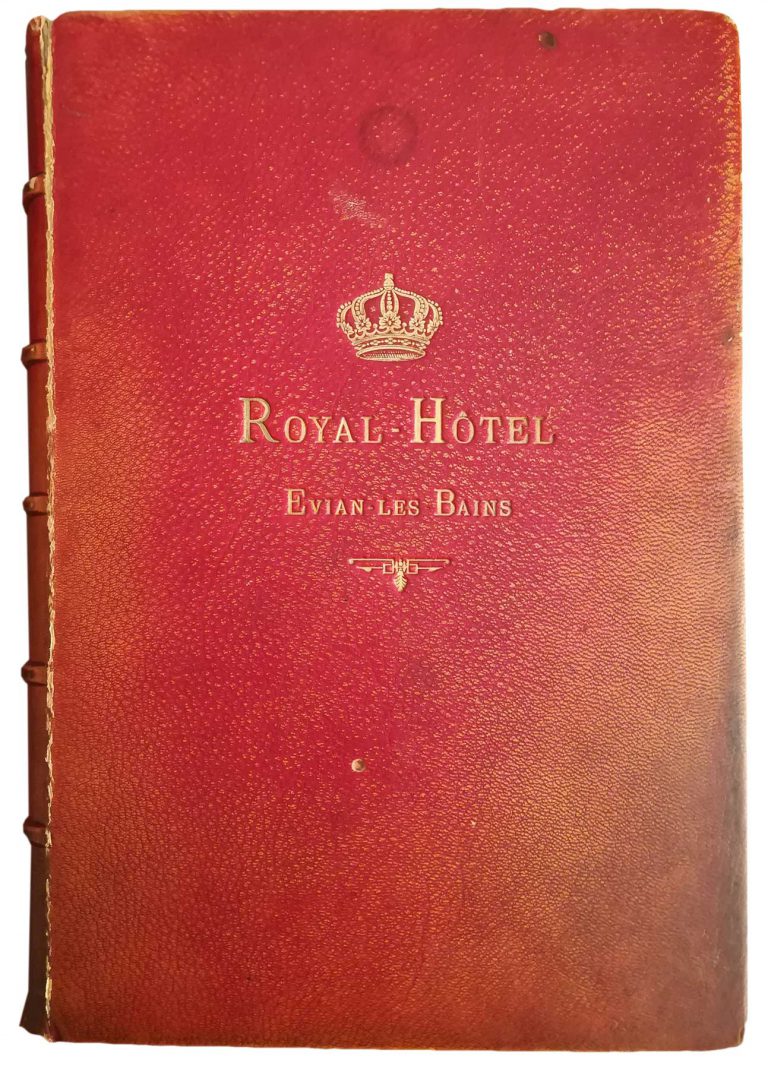
1938 guestbook, Hotel Royal in Évian-les-Bains
Évian Resort, Thonon-les-Bains
1938 guestbook, Hotel Royal in Évian-les-Bains
Évian Resort, Thonon-les-Bains
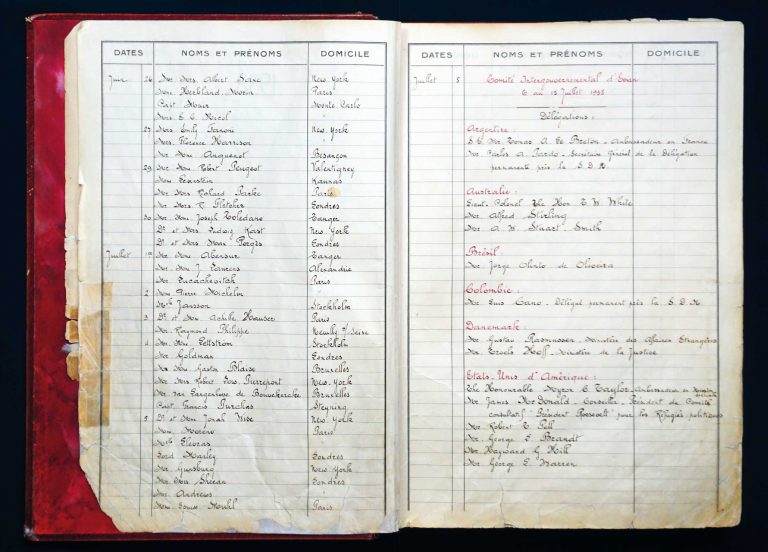
Conference participants listed in the 1938 guestbook, Hotel Royal in Évian-les-Bains 1938, p. 1/3
Évian Resort, Thonon-les-Bains
Conference participants listed in the 1938 guestbook, Hotel Royal in Évian-les-Bains 1938, p. 1/3
Évian Resort, Thonon-les-Bains

Conference participants listed in the 1938 guestbook, Hotel Royal in Évian-les-Bains 1938, p. 2/3
Évian Resort, Thonon-les-Bains
Conference participants listed in the 1938 guestbook, Hotel Royal in Évian-les-Bains 1938, p. 2/3
Évian Resort, Thonon-les-Bains
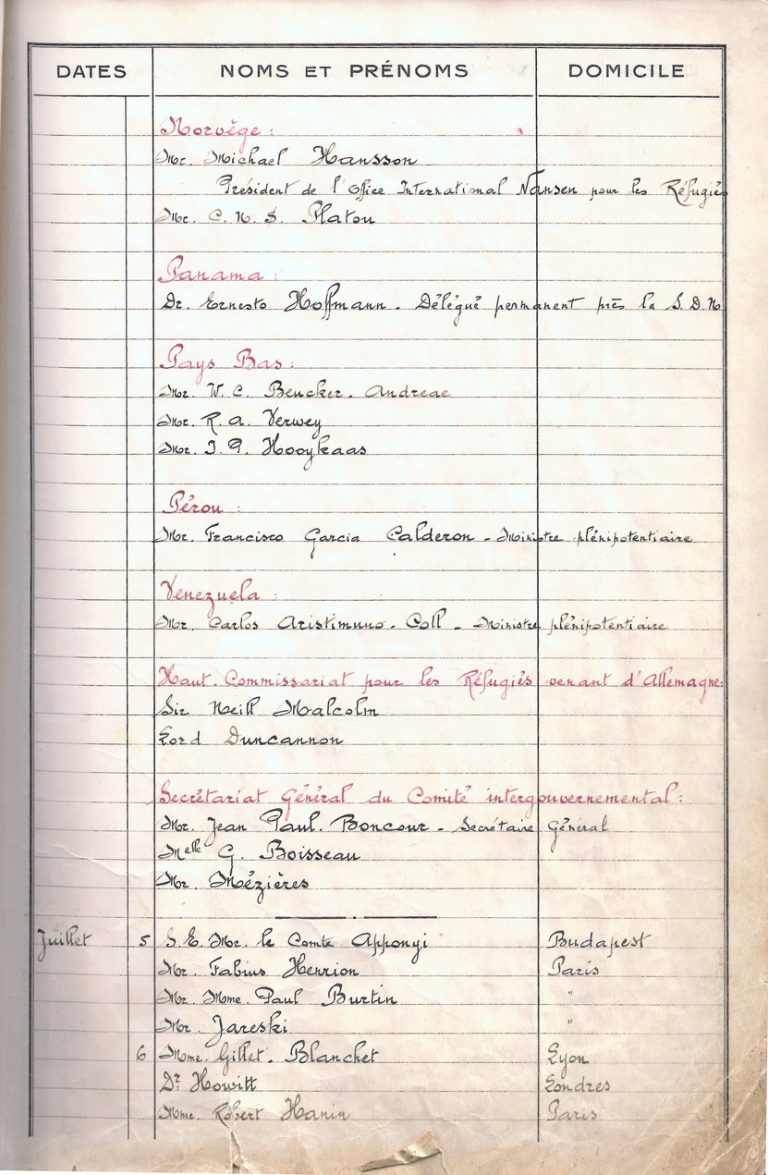
Conference participants listed in the 1938 guestbook, Hotel Royal in Évian-les-Bains 1938, p. 3/3
Évian Resort, Thonon-les-Bains
Conference participants listed in the 1938 guestbook, Hotel Royal in Évian-les-Bains 1938, p. 3/3
Évian Resort, Thonon-les-Bains
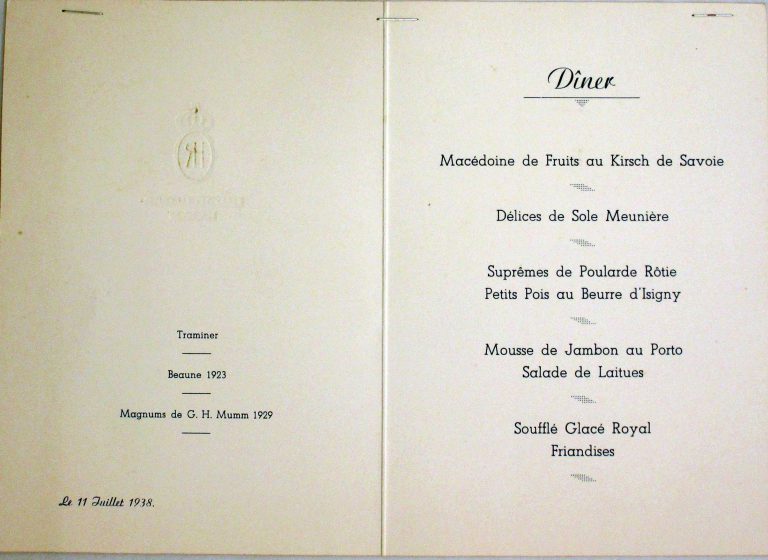
Hotel Royal wine and menu list for July 11, 1938
The Hotel Royal offers top-quality gourmet cuisine, both at daily meals and at receptions organized by the conference’s French honorary president and American president for international delegation leaders.
Franklin D. Roosevelt Library, Hyde Park, NY
Hotel Royal wine and menu list for July 11, 1938
The Hotel Royal offers top-quality gourmet cuisine, both at daily meals and at receptions organized by the conference’s French honorary president and American president for international delegation leaders.
Franklin D. Roosevelt Library, Hyde Park, NY











